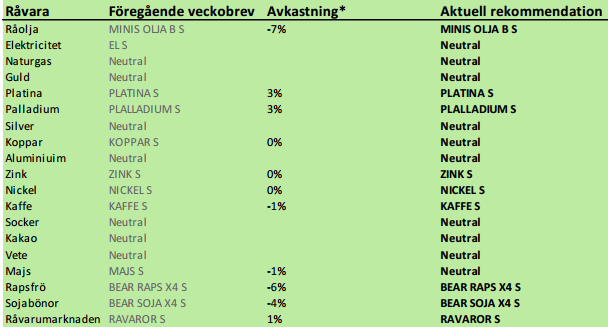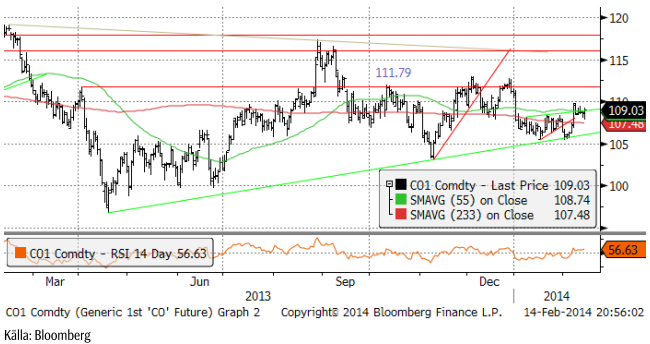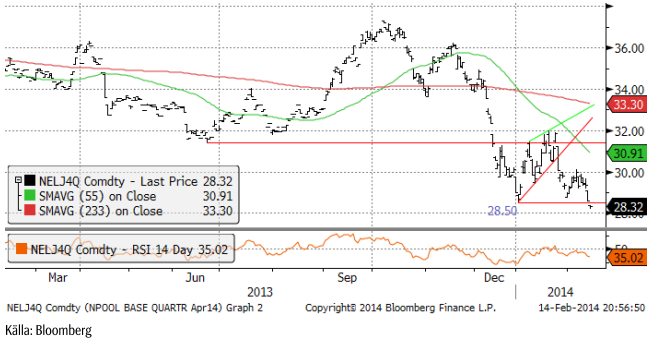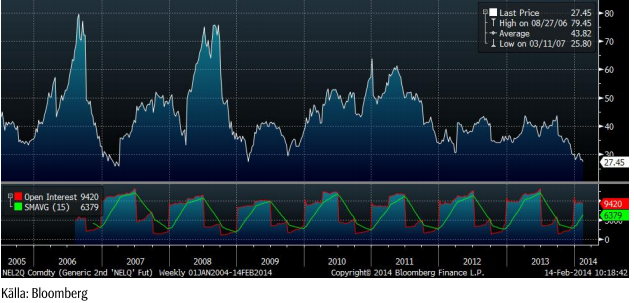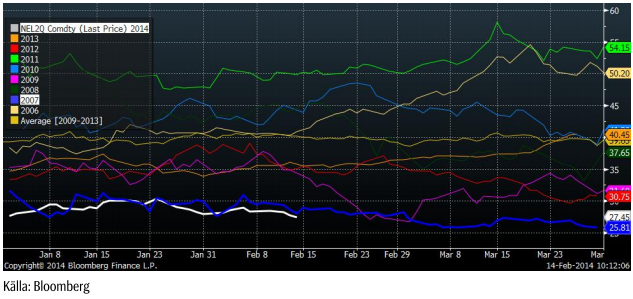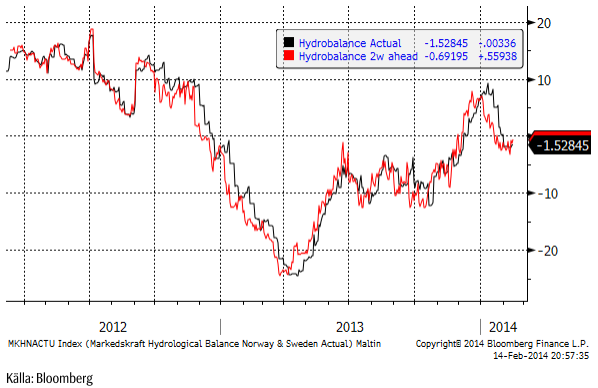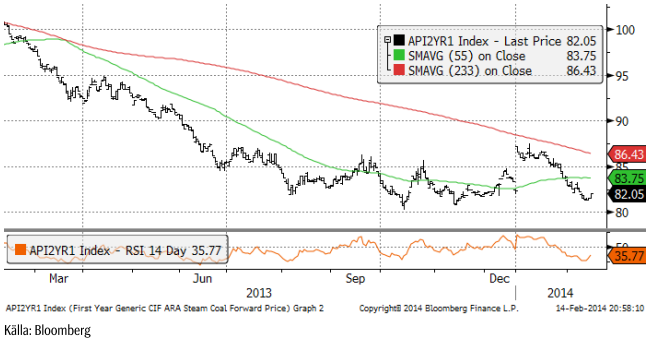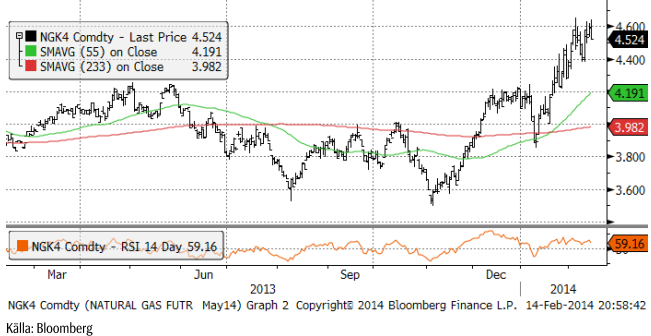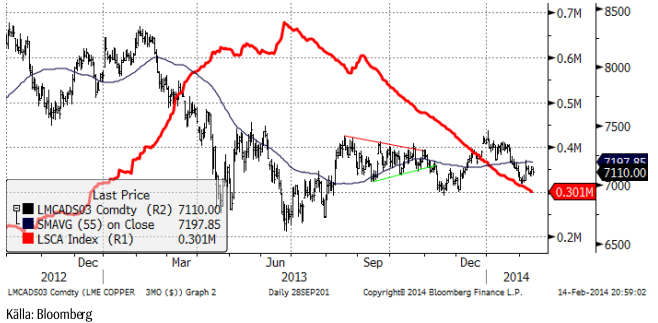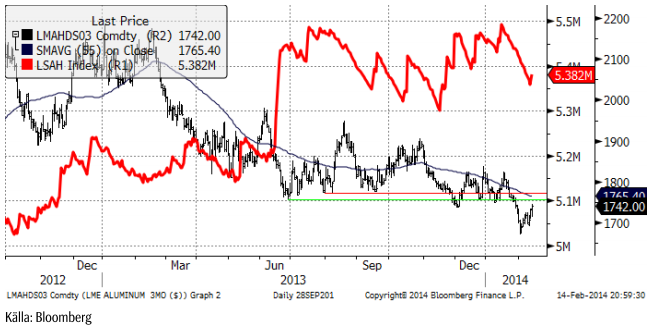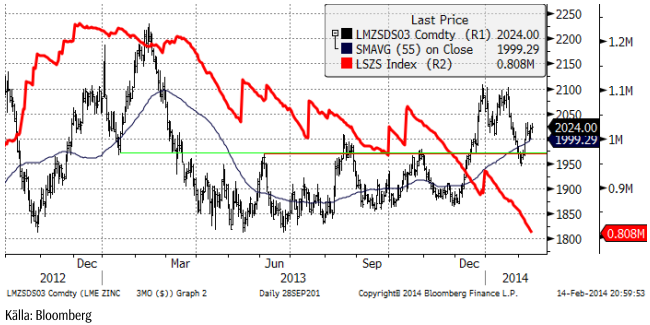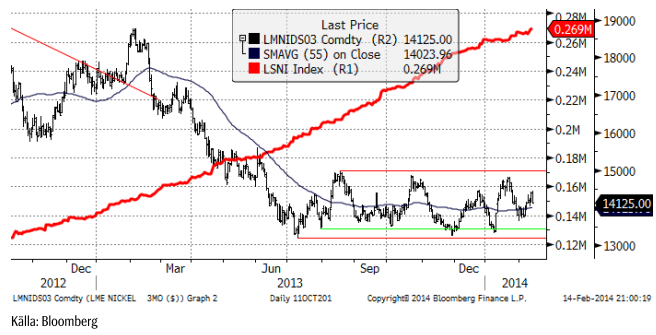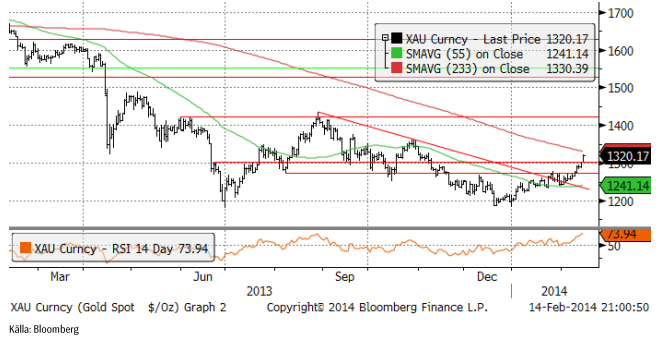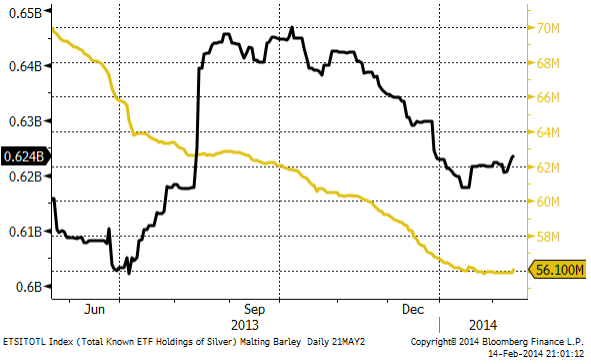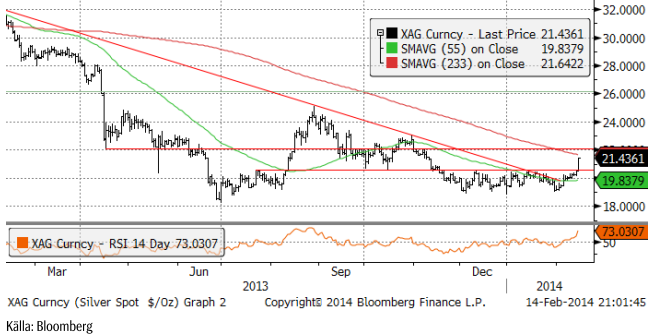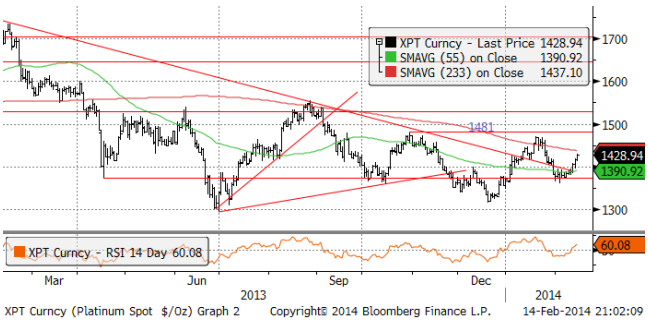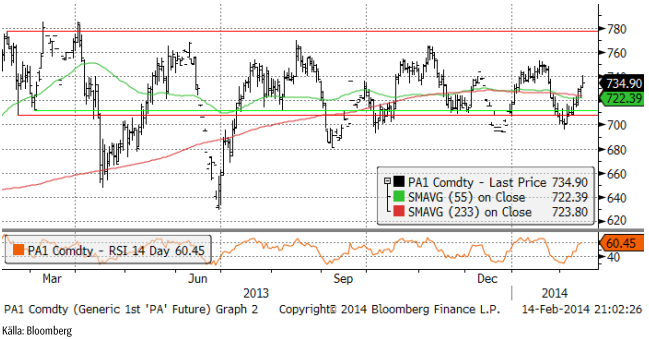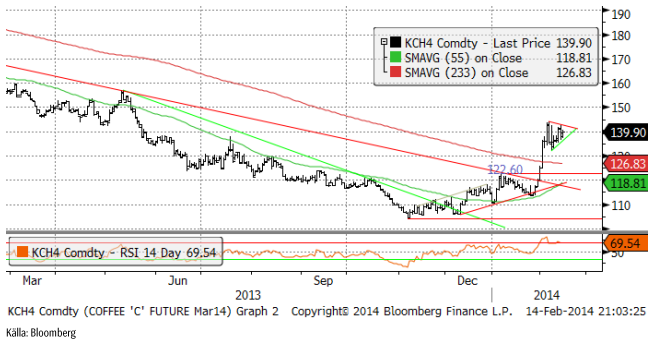Analys
SEB – Råvarukommentarer, 17 februari 2014

Rekommendationer
Råolja – Brent
Oljepriset fick styrka i veckan av att El Sharara-fältet i Libyen fick stängas igen. Marknaden har till viss del räknat in att Iran och Libyen ökar sin produktion i år. Gör de det, så faller priset. Gör de inte det, så stiger priset. Stängningen av El Sharara var alltså inte positiv ur den aspekten.
Kinas import av råolja var på rekordnivå i januari (liksom importstatistiken var för en rad råvaror).
Tekniskt är det möjligt att den konsolidering av priset vi sett efter uppgången från 106 dollar till 109 är en så kallad ”vimpel”. Om det är det, ska vi vänta oss ett utbrott på uppsidan, som har potential att ta priset till 111 dollar.
Fundamentalt genomgår oljemarknaden ett paradigmskifte där fracking radikalt ökar utbudet av råolja och minskar OPEC:s monopolställning. På längre sikt är det svårt att se något annat än ett stort prisfall på olja och vi vill handla oljemarknaden från den korta sidan. Tekniskt och i det mycket korta perspektivet av en vecka är det dock inte uteslutet, rentav troligt, att priset bryter upp och testar den övre delen av det ”gamla” prisintervallet. Med den reservationen behåller vi säljrekommendation, men rekommenderar inte att man går in i nya korta positioner på den här nivån, utan avvaktar bättre säljtillfällen.
Elektricitet
Elpriset bröt bröt stödet på 28.50 i fredags, vilket innebär att marknaden säger att skyddet mot ytterligare nedgångar har brutits. Det innebär att marknaden med hög sannolikhet kommer att handla ner priset ytterligare. Samtidigt är priset på en mycket låg nivå, som vi ser nedan.
Det är omöjligt att säga var botten är. Det lägsta priset på Q2-kontraktet år 2007 var 25.8 euro per MWh, som vi ser i nedanstående diagram över det vid var tid kortaste Q2-kontraktets pris.
I diagrammet nedan ser vi prisutvecklingen på Q2-kontrakten under det första kvartalet varje år sedan 2006. Det andra kvartalets kontrakt är på den lägsta nivån sedan åtminstone 2006. I diagrammet nedan ser vi prisutvecklingen på Q2 2014 som den vita kurvan och Q2 2007 som den blå kurvan. Som vi ser, ser prisutvecklingen i år ut att röra sig snarlikt prisutvecklingen under 2007 sedan början av året. Om detta fortsätter kommer prisnedgången att fortsätta.
Prognosen för hydrologisk balans är enligt Markedskraft mer eller mindre oförändrad från förra veckan. Vädret i Norden är dock milt och nederbördsrikt just nu.
Terminspriset för leverans av kol nästa år har fallit från 87 dollar till 82.30. Priset är alltså tillbaka på bottennivåerna från oktober. Priset ligger under produktionskostnaden för gruvorna i Australien, Sydamerika och Kanada. Den australiensiska dollar har under samma period fallit med 8% mot US-dollarn, så där är en av förklaringarna till varför kolpriset inte har stigit i US-dollartermer. Som vi ser handlade kolpriset upp i fredags. Kanske är det en vändning?
Risken är stor att de stora kollagren (”kolhögar överallt”) i Europa och det milda vädret i Norden fortsätter att påverka elpriset nedåt resten av vårvintern. Tekniskt är stödet vid 28.50 brutet, vilket är en signal att ta stoppar. Rekommendationen kan inte bli annat än neutral som högst just nu. Man ska dock vara observant på om priset går tillbaka över 28.50 euro per MWh, med tanke på att priset är på absoluta bottennivåer i ett historiskt perspektiv.
Naturgas
Det har fortsatt att vara kallt i USA, men nu börjar man se en omsvängning. Naturgaspriset har faktiskt backat lite från förra veckans 4.60 till 4.52 i fredags.
Basmetaller
Vi har en mer eller mindre positiv pristrend i basmetallerna som helhet, men med svag tendens sedan början av året. Den nedgången ”borde” vara nära sitt slut (eller inte). Den väntade optimismen efter det kinesiska nyåret har inte infunnit sig. Marknadens aktörer väntar fortfarande på ny information om tillståndet i den kinesiska efterfrågan. En pusselbit delades ut den här veckan. Januari månads importstatistik visade ovanligt hög import (+10%) och export (+10.6%). Importen intresserar naturligtvis råvarumarknaden mest. Importen av koppar och järnmalm nådde rekordnivåer. Marknaden blev dock inte fullt så imponerad, eftersom den höga importen hänger ihop med årsskifteseffekter. Som vanligt byggs det lager innan året och en del tyder på att varor har bokats och registrerats tidigare, men levereras på det nya året. Det finns en klar risk att februari-statistiken inte kommer att vara lika imponerande. Marknaden behöver se februaristatstiken för att få ökat förtroende.
Från ett tradingperspektiv, föredrar vi fortfarande att handla nickel som om den var inom ett prisintervall, och inte i en trend, även om vi favoriserar den långa sidan mer än den korta.
Koppar
Som du kunnat läsa i inledningen till basmetallsegmentet här ovan, är vi lite oroade för kopparmarknaden. Risken för ökat utbud i kombination med skuldproblemen i Kina och risken för bankrutter inom den svarta banksektorn där, utgör en klar risk för nedsidan i kopparpriset. Just nu ser det dock inte ut att ske, i närtid i alla fall. Marknaden visar stark efterfrågan med backwardation i terminskurvan. Kinas import är extremt stark. Dessutom är vi just nu i de säsongsmässigt starka första och andra kvartalen. Vi skulle inte bli förvånade om kopparpriset testar de senaste toppnoteringarna någon gång de kommande månaderna.
Ur ett tradingperspektiv, gör osäkerheterna att vi inte vill ta någon position i metallen just nu. I vår fundamentala prognos för det genomsnittliga priset för året (7450), väntar vi oss en stark marknad under det första halvåret, sedan att priset handlar svagare i Q3 och med en möjlig återhämtning under Q4.
Vi rekommenderar neutral position i koppar.
Aluminium
Aluminium har handlat starkare sedan priset noterade femårslägsta den 3 februari vid 1671 dollar. Det är alltid riskabelt att vara kort råvaror som handlar så långt ner i förhållande till produktionskostnaden. Den fundamentala balansen visar äntligen på konstruktiva tendenser. Som väntat har blankarna börjat köpa tillbaka positioner.
Konsumenter har varit på köpsidan. De tar tillvara varje prisnedgång för att köpa ytterligare hedgar. Sammantaget har detta tagit tillbaka priset till den ”gamla” tekniska stödnivån vid ca 1750 dollar. Premierna i den amerikanska marknaden har planat ut vid de extrema nivåer kring 440 dollar per ton. Enligt våra källor i den fysiska marknaden skeppas nu aluminium från Mellanöstern till USA för att dra fördel av de höga premierna. CME har startat ett nytt terminskontrakt på den fysiska premien och det visar redan snabbt ökande öppen balans. LME planerar fortfarande att introducera ett kontrakt. De nya LME-reglerna för lagerhanteringen kommer på lite längre sikt att dämpa premierna. En annan effekt av den höga premien är att finansieringsaffärer inte rullas framåt, när contangot mellan cash + premium till termin (utan premium) på LME inte ger tillräckligt avans. Risken för högre räntor i och med att FED har inlett tapering och att klockan tickar för nästa räntehöjningscykel påverkar sannolikt också.
I vilket fall, finns ett behov för ytterligare minskning i produktionen av aluminium. Så länge detta inte materialiseras, finns risken att aluminiummarknaden går in i överskott igen, om vi inte får se starkare efterfrågan än förväntat.
Vi fortsätter med neutral rekommendation på aluminium.
Zink
Zink har gjort imponerande vinster de senaste veckorna. Samtidigt, som vi noterade för ett par veckor sedan, har styrkan mattats av oron i tillväxtländerna. Terminsmarknaden handlar fortfarande cash till 3-månaders på samma nivå och längre kontrakt med ett litet contango. Givet att balanserna på längre sikt förbättras från 2015 och framåt, tycker vi att kurvan är ganska billig.
Vi rekommenderar köp av ZINK S eller BULL ZINK X4 S.
Nickel
Nickel handlar mitt i prisintervallet, vid 14,200 dollar. Det återspeglar osäkerheten kring det indonesiska exportförbudet. Marknadens aktörer drar sig för att ta positioner i avvaktan på nyheter från den indonesiska regeringen. Värt att notera är att priset på nickelmalm från Malaysia, som delvis är ett alternativ för NPI-producenter, har gått upp i pris. Malm inom Kina blir också dyrare. Scenariot vi beskrivit tidigare för nickel är i stort sett fortfarande relevant och innebär att det finns en begränsad nedsida i nickelpriset. Risken är på uppsidan för resten av året.
Guld
Det är nu tydligt att guld verkligen noterade en botten vid 1200 dollar per uns. Fredagens handel var haussartad. Det är dock vanligt att det sista man ser av en prisuppgång i guld är en ”spik” av det slaget. Det känns inte rätt att så här sent i en uppgång som pågått i två månader, gå in och köpa. Vi tycker det är bättre att avvakta den rekyl som brukar följa.
ETF-statistiken visar infllöden i silver-ETF:er (svart kurva) men inte lika tydligt i ETF-er på guld (gul kurva).
Vi fortsätter tills vidare med neutral vy på guld.
Silver
Silver bröt motståndet i fredags och steg kraftigt. Prisrörelsen var mycket snabb och priset är nu nästan uppe vid nästa motstånd, vilket gör att det är för sent att rekommendera köp.
Vi fortsätter med neutral vy på silver.
Platina & Palladium
Platina, trots sin mycket lugnare utveckling än både guld och silver, har ett marknadsbeteende som i början av en trendvändning uppåt. Rekylen nedåt efter uppgången i början på året stannade på en högre nivå än botten i december. Det är ett positivt tecken. Trendlinjen för den fallande pristrenden bröts i början av januari. Även om det skulle komma en liten rekyl nedåt nu, skulle det inte förändra bilden av att en större trendvändning är på gång.
Palladium, där prisuppgången varit snabb seden botten för ett par veckor sedan, mötte säljare i fredags, vilket fick priset att stänga långt under dagens högsta notering. Palladium är alltså fortsatt ”cappad” på uppsidan och eftersom priset redan är ”högt” inom intervallet, rekommenderar vi neutral position.
Vi rekommenderar alltså köp av både platina och neutral i palladium.
Kaffe
Det har varit skyfall i Sao Paulo de senaste dagarna. Regnvädret rör sig norrut mot kaffeodlingarna i Minas Gerais. Prisuppgången stannade vid en nivå kring 140 cent per pund när väderleksprognoserna visade att regnvädret faktiskt var på väg norrut. Tekniskt har priset bildat en ”vimpel” vid 140 cent och en sådan formation brukar följas av antingen ett brott uppåt (mot 160 cent) eller ett fall tillbaka. Marknaden försöker nu som bäst få grepp om vad den långsiktiga effekten av torkan är på kaffeskörden i Brasilien. Det är möjligt att man kommer fram till att minskningen i skörd de kommande åren är så stor att priset borde gå upp. Vi ska komma ihåg att USDA genom en survey under hösten räknat ut att den genomsnittliga produktionskostnaden i Brasilien är 147 cent. Priset på 140 cent idag är alltså inte så högt att det skulle locka så många kaffeodlare att expandera. Bortfallen produktion kanske inte ersätts. Det talar för en fortsatt prisuppgång.
Vietnam rapporterade att exporten i januari var 36% lägre än förra året.
Vi fortsätter med köprekommendation.
Det finns nu också mini futures på kaffe, som erbjuder högre hävstång. Se SEB-bankens utbud.
[box]SEB Veckobrev Veckans råvarukommentar är producerat av SEB Merchant Banking och publiceras i samarbete och med tillstånd på Råvarumarknaden.se[/box]
Disclaimer
The information in this document has been compiled by SEB Merchant Banking, a division within Skandinaviska Enskilda Banken AB (publ) (“SEB”).
Opinions contained in this report represent the bank’s present opinion only and are subject to change without notice. All information contained in this report has been compiled in good faith from sources believed to be reliable. However, no representation or warranty, expressed or implied, is made with respect to the completeness or accuracy of its contents and the information is not to be relied upon as authoritative. Anyone considering taking actions based upon the content of this document is urged to base his or her investment decisions upon such investigations as he or she deems necessary. This document is being provided as information only, and no specific actions are being solicited as a result of it; to the extent permitted by law, no liability whatsoever is accepted for any direct or consequential loss arising from use of this document or its contents.
About SEB
SEB is a public company incorporated in Stockholm, Sweden, with limited liability. It is a participant at major Nordic and other European Regulated Markets and Multilateral Trading Facilities (as well as some non-European equivalent markets) for trading in financial instruments, such as markets operated by NASDAQ OMX, NYSE Euronext, London Stock Exchange, Deutsche Börse, Swiss Exchanges, Turquoise and Chi-X. SEB is authorized and regulated by Finansinspektionen in Sweden; it is authorized and subject to limited regulation by the Financial Services Authority for the conduct of designated investment business in the UK, and is subject to the provisions of relevant regulators in all other jurisdictions where SEB conducts operations. SEB Merchant Banking. All rights reserved.
Analys
Brent crude ticks higher on tension, but market structure stays soft

Brent crude has climbed roughly USD 1.5-2 per barrel since Friday, yet falling USD 0.3 per barrel this mornig and currently trading near USD 67.25/bbl after yesterday’s climb. While the rally reflects short-term geopolitical tension, price action has been choppy, and crude remains locked in a broader range – caught between supply-side pressure and spot resilience.

Prices have been supported by renewed Ukrainian drone strikes targeting Russian infrastructure. Over the weekend, falling debris triggered a fire at the 20mtpa Kirishi refinery, following last week’s attack on the key Primorsk terminal.
Argus estimates that these attacks have halted ish 300 kbl/d of Russian refining capacity in August and September. While the market impact is limited for now, the action signals Kyiv’s growing willingness to disrupt oil flows – supporting a soft geopolitical floor under prices.
The political environment is shifting: the EU is reportedly considering sanctions on Indian and Chinese firms facilitating Russian crude flows, while the U.S. has so far held back – despite Bessent warning that any action from Washington depends on broader European participation. Senator Graham has also publicly criticized NATO members like Slovakia and Hungary for continuing Russian oil imports.
It’s worth noting that China and India remain the two largest buyers of Russian barrels since the invasion of Ukraine. While New Delhi has been hit with 50% secondary tariffs, Beijing has been spared so far.
Still, the broader supply/demand balance leans bearish. Futures markets reflect this: Brent’s prompt spread (gauge of near-term tightness) has narrowed to the current USD 0.42/bl, down from USD 0.96/bl two months ago, pointing to weakening backwardation.
This aligns with expectations for a record surplus in 2026, largely driven by the faster-than-anticipated return of OPEC+ barrels to market. OPEC+ is gathering in Vienna this week to begin revising member production capacity estimates – setting the stage for new output baselines from 2027. The group aims to agree on how to define “maximum sustainable capacity,” with a proposal expected by year-end.
While the IEA pegs OPEC+ capacity at 47.9 million barrels per day, actual output in August was only 42.4 million barrels per day. Disagreements over data and quota fairness (especially from Iraq and Nigeria) have already delayed this process. Angola even quit the group last year after being assigned a lower target than expected. It also remains unclear whether Russia and Iraq can regain earlier output levels due to infrastructure constraints.
Also, macro remains another key driver this week. A 25bp Fed rate cut is widely expected tomorrow (Wednesday), and commodities in general could benefit a potential cut.
Summing up: Brent crude continues to drift sideways, finding near-term support from geopolitics and refining strength. But with surplus building and market structure softening, the upside may remain capped.
Analys
Volatile but going nowhere. Brent crude circles USD 66 as market weighs surplus vs risk

Brent crude is essentially flat on the week, but after a volatile ride. Prices started Monday near USD 65.5/bl, climbed steadily to a mid-week high of USD 67.8/bl on Wednesday evening, before falling sharply – losing about USD 2/bl during Thursday’s session.

Brent is currently trading around USD 65.8/bl, right back where it began. The volatility reflects the market’s ongoing struggle to balance growing surplus risks against persistent geopolitical uncertainty and resilient refined product margins. Thursday’s slide snapped a three-day rally and came largely in response to a string of bearish signals, most notably from the IEA’s updated short-term outlook.
The IEA now projects record global oversupply in 2026, reinforcing concerns flagged earlier by the U.S. EIA, which already sees inventories building this quarter. The forecast comes just days after OPEC+ confirmed it will continue returning idle barrels to the market in October – albeit at a slower pace of +137,000 bl/d. While modest, the move underscores a steady push to reclaim market share and adds to supply-side pressure into year-end.
Thursday’s price drop also followed geopolitical incidences: Israeli airstrikes reportedly targeted Hamas leadership in Doha, while Russian drones crossed into Polish airspace – events that initially sent crude higher as traders covered short positions.
Yet, sentiment remains broadly cautious. Strong refining margins and low inventories at key pricing hubs like Europe continue to support the downside. Chinese stockpiling of discounted Russian barrels and tightness in refined product markets – especially diesel – are also lending support.
On the demand side, the IEA revised up its 2025 global demand growth forecast by 60,000 bl/d to 740,000 bl/d YoY, while leaving 2026 unchanged at 698,000 bl/d. Interestingly, the agency also signaled that its next long-term report could show global oil demand rising through 2050.
Meanwhile, OPEC offered a contrasting view in its latest Monthly Oil Market Report, maintaining expectations for a supply deficit both this year and next, even as its members raise output. The group kept its demand growth estimates for 2025 and 2026 unchanged at 1.29 million bl/d and 1.38 million bl/d, respectively.
We continue to watch whether the bearish supply outlook will outweigh geopolitical risk, and if Brent can continue to find support above USD 65/bl – a level increasingly seen as a soft floor for OPEC+ policy.
Analys
Waiting for the surplus while we worry about Israel and Qatar

Brent crude makes some gains as Israel’s attack on Hamas in Qatar rattles markets. Brent crude spiked to a high of USD 67.38/b yesterday as Israel made a strike on Hamas in Qatar. But it wasn’t able to hold on to that level and only closed up 0.6% in the end at USD 66.39/b. This morning it is starting on the up with a gain of 0.9% at USD 67/b. Still rattled by Israel’s attack on Hamas in Qatar yesterday. Brent is getting some help on the margin this morning with Asian equities higher and copper gaining half a percent. But the dark cloud of surplus ahead is nonetheless hanging over the market with Brent trading two dollar lower than last Tuesday.

Geopolitical risk premiums in oil rarely lasts long unless actual supply disruption kicks in. While Israel’s attack on Hamas in Qatar is shocking, the geopolitical risk lifting crude oil yesterday and this morning is unlikely to last very long as such geopolitical risk premiums usually do not last long unless real disruption kicks in.
US API data yesterday indicated a US crude and product stock build last week of 3.1 mb. The US API last evening released partial US oil inventory data indicating that US crude stocks rose 1.3 mb and middle distillates rose 1.5 mb while gasoline rose 0.3 mb. In total a bit more than 3 mb increase. US crude and product stocks usually rise around 1 mb per week this time of year. So US commercial crude and product stock rose 2 mb over the past week adjusted for the seasonal norm. Official and complete data are due today at 16:30.
A 2 mb/week seasonally adj. US stock build implies a 1 – 1.4 mb/d global surplus if it is persistent. Assume that if the global oil market is running a surplus then some 20% to 30% of that surplus ends up in US commercial inventories. A 2 mb seasonally adjusted inventory build equals 286 kb/d. Divide by 0.2 to 0.3 and we get an implied global surplus of 950 kb/d to 1430 kb/d. A 2 mb/week seasonally adjusted build in US oil inventories is close to noise unless it is a persistent pattern every week.
US IEA STEO oil report: Robust surplus ahead and Brent averaging USD 51/b in 2026. The US EIA yesterday released its monthly STEO oil report. It projected a large and persistent surplus ahead. It estimates a global surplus of 2.2 m/d from September to December this year. A 2.4 mb/d surplus in Q1-26 and an average surplus for 2026 of 1.6 mb/d resulting in an average Brent crude oil price of USD 51/b next year. And that includes an assumption where OPEC crude oil production only averages 27.8 mb/d in 2026 versus 27.0 mb/d in 2024 and 28.6 mb/d in August.
Brent will feel the bear-pressure once US/OECD stocks starts visible build. In the meanwhile the oil market sits waiting for this projected surplus to materialize in US and OECD inventories. Once they visibly starts to build on a consistent basis, then Brent crude will likely quickly lose altitude. And unless some unforeseen supply disruption kicks in, it is bound to happen.
US IEA STEO September report. In total not much different than it was in January

US IEA STEO September report. US crude oil production contracting in 2026, but NGLs still growing. Close to zero net liquids growth in total.

-

 Nyheter4 veckor sedan
Nyheter4 veckor sedanMeta bygger ett AI-datacenter på 5 GW och 2,25 GW gaskraftverk
-

 Nyheter4 veckor sedan
Nyheter4 veckor sedanAker BP gör ett av Norges största oljefynd på ett decennium, stärker resurserna i Yggdrasilområdet
-

 Nyheter4 veckor sedan
Nyheter4 veckor sedanSommarens torka kan ge högre elpriser i höst
-

 Analys4 veckor sedan
Analys4 veckor sedanBrent edges higher as India–Russia oil trade draws U.S. ire and Powell takes the stage at Jackson Hole
-

 Nyheter3 veckor sedan
Nyheter3 veckor sedanMahvie Minerals är verksamt i guldrikt område i Finland
-

 Analys4 veckor sedan
Analys4 veckor sedanIncreasing risk that OPEC+ will unwind the last 1.65 mb/d of cuts when they meet on 7 September
-

 Nyheter3 veckor sedan
Nyheter3 veckor sedanNeil Atkinson spår att priset på olja kommer att stiga till 70 USD
-

 Analys2 veckor sedan
Analys2 veckor sedanOPEC+ in a process of retaking market share


